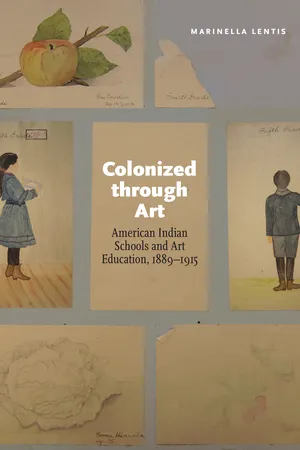
Colonized through Art
American Indian Schools and Art Education, 1889–1915
- 486 pages
- English
- ePUB (mobile friendly)
- Available on iOS & Android
About This Book
Colonized through Art explores how the federal government usedart education for American Indian children as an instrument for the "colonization of consciousness, " hoping to instill the values and ideals of Western society while simultaneously maintaining a political, social, economic, and racial hierarchy. Focusing onthe Albuquerque Indian School in New Mexico, the Sherman Institute in Riverside, California, and the world's fairs and local community exhibitions, Marinella Lentis examines how the U.S. government's solution to the "Indian problem" at the end of the nineteenth century emphasizededucation and assimilation.Educational theories at the time viewed art as the foundation of morality and as a way to promote virtues and personal improvement. These theories made the subject of art a natural tool for policy makers and educators to use in achieving their assimilationist goals of turning student "savages" into civilized men and women. Despite such educational regimes for students, however, indigenous ideas about art oftentimes emerged "from below, " particularly from well-known art teachers such asArizona Swayney and Angel DeCora. Colonized through Art explores howAmerican Indian schools taught children to abandon their cultural heritage and produce artificially "native" crafts that were exhibited at local and international fairs.The purchase of these crafts by the general public turned students' work into commodities and schools into factories.
Frequently asked questions
Information
Table of contents
- Cover
- Title Page
- Copyright Page
- Dedication
- Epigraph
- Contents
- List of Illustrations
- List of Tables
- Acknowledgments
- Introduction
- List of Abbreviations
- 1. Art “Lifts Them to Her Own High Level”
- 2. “An Indispensable Adjunct to All Training of This Kind”
- 3. “Show Him the Needs of Civilization and How to Adapt His Work to the Needs of the Hour”
- 4. “The Administration Has No Sympathy with Perpetuation of Any Except the Most Substantial of Indian Handicraft”
- 5. “Drawing and All the Natural Artistic Talents of the Pupils Are Encouraged and Cultivated”
- 6. “Susie Chase-the-Enemy and Her Friends Do Good Work”
- 7. “The Comparison with the Work of White Scholars Is Not Always to the Credit of the Latter”
- Conclusion
- Appendix A
- Appendix B
- Appendix C
- Notes
- Bibliography
- Index
- About Marinella Lentis